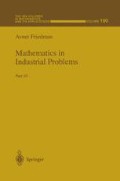Abstract
Conventional and high-speed metal cutting processes are in common use in industry. For example, in order to reduce the weight of an airplane or an automobile, a large amount of material is shaved off metal panels while maintaining required material strength of the panels. The development of a new machining process requires accurate prediction of pertinent physical information such as cutting forces and temperature. Process features such as tool geometry and cutting speed directly influence chip morphology, cutting forces, final product dimensionality, and life of the tool. Computer simulation of the cutting process can potentially reduce the number of design iterations for cutting tool design and result in cost saving. On April 25, 1997 Troy D. Marusich from Third Wave Systems described a finite element scheme he developed jointly with Ortiz [1]. He presented results which correctly predict (i) continuous or shear-localized chip morphologies (for different metals); (ii) temperature and stress distribution throughout the chip, workpiece and tool; and (iii) orthogonal cutting force components.
Access this chapter
Tax calculation will be finalised at checkout
Purchases are for personal use only
Preview
Unable to display preview. Download preview PDF.
References
T.D. Marusich and M. Ortiz, Modelling and simulation of high-speed machining, International Journal for Numerical Methods in Engineering, 38 (1995), 3675–3694.
P.G. Ciarlet, Mathematical Elasticity, Vol. 1: Three Dimensional Elasticity, North-Holland, Amsterdam (1993).
M. Moran, M. Ortiz and C.F. Shih, Formulation of implicit finite element methods for multiplicative finite deformation plasticity, International Journal for Numerical Methods in Engineering, 29 (1990), 483–514.
A. Cuitino, and M. Ortiz, A material independent method for extending stress update algorithms from small-strain plasticity to finite plasticity with multiplicative kinematics, Engineering Computations, 9 (1992), 437–451.
A. Friedman, Mathematics in Industrial Problems, Part 8, IMA Volume 83, Springer-Verlag, New York (1997).
A. Friedman, Mathematics in Industrial Problems, IMA Volume 16, Springer-Verlag, New York (1988).
T.J. Burns and M.A. Davies, A nonlinear dynamics model for chip segmentation in machining, Physical Review Letters, to appear.
L.A. Romero, The stability of rapidly stretching plastic jets, Journal Applied Physics, 65 (1989), 3006–16.
Author information
Authors and Affiliations
Rights and permissions
Copyright information
© 1998 Springer Science+Business Media New York
About this chapter
Cite this chapter
Friedman, A. (1998). Simulation of production metal cutting Processes. In: Mathematics in Industrial Problems. The IMA Volumes in Mathematics and its Applications, vol 100. Springer, New York, NY. https://doi.org/10.1007/978-1-4612-1730-5_15
Download citation
DOI: https://doi.org/10.1007/978-1-4612-1730-5_15
Publisher Name: Springer, New York, NY
Print ISBN: 978-1-4612-7257-1
Online ISBN: 978-1-4612-1730-5
eBook Packages: Springer Book Archive

